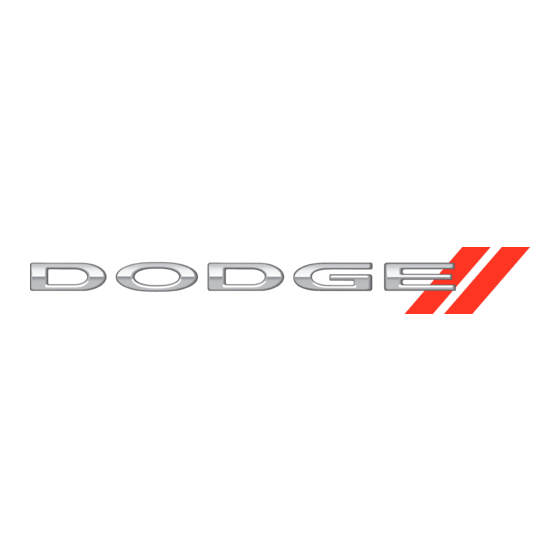Dodge HXT405A Manuale - Pagina 7
Sfoglia online o scarica il pdf Manuale per Automobile Accessories Dodge HXT405A. Dodge HXT405A 9. For hydroil, torque-arm speed reducers taper bushed for char-lynn h, s, t and 2000 series 6b spline motors

A DODGE TORQUE-ARM Speed Reducer can be
disassembled and reassembled by careful attention to
the instructions following, using tools normally found
in a maintenance department.
Cleanliness
is
very
introduction of dirt into the bearings and other parts of
the reducer. A tank of clean solvent, an arbor press,
and equipment for heating bearings and gears should
be available for shrinking these parts on shafts.
Our factory is prepared to repair reducers for
customers who do not have proper facilities or who for
any reason desire factory service.
The oil seals are of the rubbing type and considerable
care should be used during disassembly and
reassembly to avoid damage to the surface on which
the seals rub.
The keyseat in the input shaft as well as any sharp
edges on the output hub should be covered with tape
or paper before disassembly or reassembly. Also be
careful to remove any burrs or nicks on surfaces of
the input shaft or output hub before disassembly or
reassembly.
ORDERING PARTS:
When ordering parts for reducer, specify reducer size
number, reducer serial number, part name, part
number and quantity.
It is strongly recommended that when a pinion or gear
is replaced, the mating gear or pinion be replaced
also.
If the large gear on the output hub must be replaced, it
is recommended that an output hub assembly with a
gear assembled on the hub be ordered to secure
undamaged surfaces on the output hub where the oil
seals rub. However, if it is desired to use the old
output hub, press the gear and bearing off and
examine the rubbing surface under the oil seal
carefully for possible scratching or other damage
resulting from the pressing operation. To prevent oil
leakage at the shaft oil seals the smooth surface of
the output hub must not be damaged.
If any parts must be pressed from a shaft or from the
output hub, this should be done before ordering parts
to make sure that none of the bearings or other parts
are damaged in removal. Do not press against outer
race of any bearing.
Because old shaft oil seals may be damaged in
disassembly it is advisable to order replacements for
these parts.
If replacing a bearing or a shaft, it is advisable to order
a set of shims for adjustment of bearings on the shaft
assembly. If replacing a housing, a set of shims
should be ordered for each shaft assembly because
the adjustment of the bearings on each shaft
assembly is affected.
REMOVING TAPER BUSHED REDUCER FROM SHAFT:
WARNING
To ensure that drive is not unexpectedly
started, turn off and lock out or tag power
source before proceeding. Failure to observe
these precautions could result in bodily injury.
REPLACEMENT OF PARTS
important
to
prevent
External loads may cause machine movement.
Block machine before removing any drive train
components. Failure to observe these precautions
could result in bodily injury.
the
1. Remove bushing screws.
2. Place the screws in the threaded holes provided in
the bushing flanges. Tighten the screws alternately
and evenly until the bushings are free on the shaft.
For ease of tightening screws make sure screw
threads and threaded holes in bushing flanges are
clean.
3. Remove the outside bushing, the reducer and then
the inboard bushing.
DISASSEMBLY:
1. Remove all bolts from housing. Drive back hollow
dowel pins on either side of housing. Remove
back-up plates and snap rings on the output hub
on taper-bushed reducers. Open housing evenly to
prevent damage to parts inside.
2. Lift shaft, gear and bearing assemblies from
housing.
3. Remove seals, seal carriers and bearing cups from
housing.
REASSEMBLY:
1. Output Hub Assembly: Heat gear to 325º to
350ºF for shrinking onto output hub. Heat bearing
cones to 270º to 290ºF for shrinking onto output
hub.
2. Input Shaft Assembly: Shaft and pinion are
integral. Heat bearing cones to 270º to 290ºF for
shrinking onto shaft.
3. Drive the dowel pins back into position in the right-
hand housing half. Place housing half on blocks to
allow for protruding end of output hub. Install
bearing cups in right-hand housing half making
sure they are properly seated.
4. Mesh output hub gear and input shaft assembly
together and set in place in housing. Make sure
bearing rollers (cones) are properly seated in their
cups. Set bearing cups for left-hand housing half in
place on their rollers.
5. Clean housing flange surfaces on both halves,
making sure not to nick or scratch flange face.
Place a new bead of gasket eliminator on flange
face and spread evenly over entire flange leaving
no bare spots. Place other housing half into
position and tap with a soft hammer (rawhide not
lead hammer) until housing bolts can be used or
draw housing halves together. Torque housing
bolts per torque values listed below.
6. Place output hub seal carrier in position without
shims and install two carrier screws diametrically
opposed. Torque each screw to 25 lb.-ins. Rotate
the output hub to roll in the bearings and then
torque each screw once to 50 lb.-ins. Do not
retorque screws.
7
WARNING
